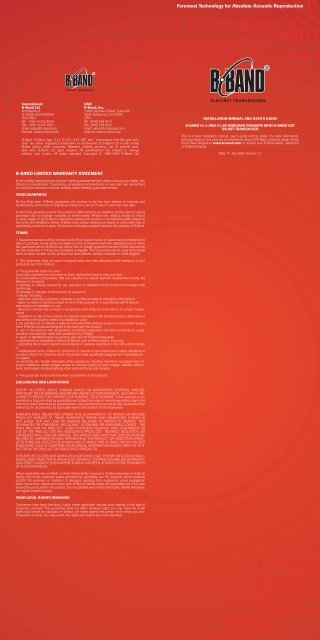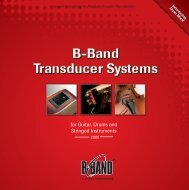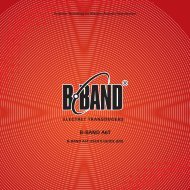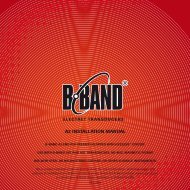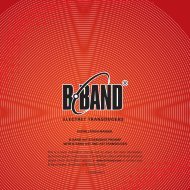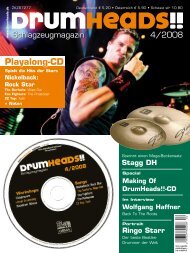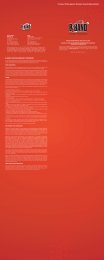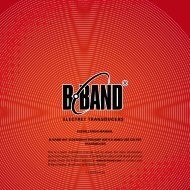Installation Instructions - B-Band, Inc.
Installation Instructions - B-Band, Inc.
Installation Instructions - B-Band, Inc.
Create successful ePaper yourself
Turn your PDF publications into a flip-book with our unique Google optimized e-Paper software.
Foremost Technology for Absolute Acoustic ReproductionInternational:USA:B-<strong>Band</strong> LtdB-<strong>Band</strong>, <strong>Inc</strong>.Konttisentie 8 10909 Vanowen Street, Suite 300FI-40800 VAAJAKOSKI North Hollywood, CA 91605FINLANDUSATel: +358 14 332 9050 Tel: (818) 508 9412Fax: +358 14 332 9001 Fax: (818) 508 9413Email: sales@b-band.comEmail: sales@b-bandusa.comInternet: www.b-band.comInternet: www.b-band.comB-<strong>Band</strong>, B-<strong>Band</strong> logo, A1.2 A1.2N, UST, AST and “microscopic lens-like gas bubbles”are either registered trademarks or trademarks of B-<strong>Band</strong> Ltd in the UnitedStates and/or other countries. Patented, patents pending. List of patents availablefrom B-<strong>Band</strong> Ltd upon request. All specifications are subject to changewithout prior notice. All rights reserved. Copyright © 1996-2006 B-<strong>Band</strong> Ltd.INSTALLATION MANUAL AND USER´S GUIDEB-BAND A1.2 AND A1.2N ONBOARD PREAMPS WITH B-BAND USTOR AST TRANSDUCERThis is a basic installation manual, user’s guide and tip sheet. For more information,technical support and pictures of installations about all B-<strong>Band</strong> products please checkthe B-<strong>Band</strong> website at www.b-band.com or contact your B-<strong>Band</strong> dealer, distributoror B-<strong>Band</strong> directly.Date: 4 th July 2006. Version 1.0.B-BAND LIMITED WARRANTY STATEMENTIn the unlikely event that your product needs guarantee service, please contact your dealer, distributoror manufacturer. To avoid any unnecessary inconvenience on your part, we recommendyou read this instruction manual carefully before seeking guarantee service.YOUR GUARANTEEBy this Guarantee, B-<strong>Band</strong> guarantees the product to be free from defects in materials andworkmanship at the date of original purchase for a period of one (1) year from that date.If within the guarantee period the product is determined to be defective (at the date of originalpurchase) due to improper materials or workmanship, B-<strong>Band</strong> will, without charge for labouror parts, repair or (at B-<strong>Band</strong>’s discretion) replace the product or its defective parts subject tothe terms and limitations below. B-<strong>Band</strong> may replace defective products or parts with new orrefurbished products or parts. All products and parts replaced become the property of B-<strong>Band</strong>.TERMS1. Guarantee services will be provided only if the original invoice or sales receipt (indicating thedate of purchase, model name and dealer’s name) is presented with the defective product withinthe guarantee period. B-<strong>Band</strong> may refuse free-of-charge guarantee service if these documentsare not presented or if they are incomplete or illegible. This Guarantee will not apply if the modelname or serial number on the product has been altered, deleted, removed or made illegible.2. This Guarantee does not cover transport costs and risks associated with transport of yourproduct to and from B-<strong>Band</strong>.3. This guarantee does not cover:a) periodic maintenance and repair or parts replacement due to wear and tear.b) consumables (components that are expected to require periodic replacement during thelifetime of a product)c) damage or defects caused by use, operation or treatment of the product inconsistent withnormal used) damage or changes to the product as a result of:i. misuse, including:- treatment resulting in physical, cosmetic or surface damage or changes to the product- failure to install or use the product for its normal purpose or in accordance with B-<strong>Band</strong>’sinstructions on installation or use- failure to maintain the product in accordance with B-<strong>Band</strong>’s instructions on proper maintenance- installation or use of the product in a manner inconsistent with the technical or safety laws orstandards in the country where it is installed or usedii. the condition of or defects in systems with which the product is used or incorporated exceptother B-<strong>Band</strong>’s products designed to be used with the productiii. use of the product with accessories, peripheral equipment and other products of a type,condition and standard other than prescribed by B-<strong>Band</strong>iv. repair or attempted repair by persons who are not B-<strong>Band</strong> employeesv. adjustments or adaptations without B-<strong>Band</strong>’s prior written consent, including:- upgrading the product beyond specifications or features described in the instruction manual,or- modifications to the product to conform it to national or local technical or safety standards incountries other than those for which the product was specifically designed and manufacturedvi. neglectvii. accidents, fire, liquids, chemicals, other substances, flooding, vibrations, excessive heat, improperventilation, power surges, excess or incorrect supply or input voltage, radiation, electrostaticdischarges including lighting, other external forces and impacts.4. This guarantee covers only hardware components of the product.EXCLUSIONS AND LIMITATIONSEXCEPT AS STATED ABOVE, B-BAND MAKES NO WARRANTIES (EXPRESS, IMPLIED,STATUTORY OR OTHERWISE) REGARDING PRODUCT PERFORMANCE, ACCURACY, RE-LIABILITY, FITNESS FOR A PARTICULAR PURPOSE, OR OTHERWISE. If this exclusion is notpermitted or fully permitted by applicable law, B-<strong>Band</strong> excludes or limits its warranties only to themaximum extent permitted by applicable law. Any warranty that cannot be fully excluded will belimited (as far as permitted by applicable law) to the duration of this Guarantee.B-BAND’S ONLY OBLIGATION UNDER THIS GUARANTEE IS TO REPAIR OR REPLACEPRODUCTS SUBJECT TO THESE GUARANTEE TERMS AND CONDITIONS. B-BAND ISNOT LIABLE FOR ANY LOSS OR DAMAGE RELATING TO PRODUCTS, SERVICE, THISGUARANTEE OR OTHERWISE, INCLUDING - ECONOMIC OR INTANGIBLE LOSSES - THEPRICE PAID FOR THE PRODUCT - LOSS OF PROFITS, REVENUE, DATA, ENJOYMENT ORUSE OF THE PRODUCT OR ANY ASSOCIATED PRODUCTS - INDIRECT, INCIDENTAL ORCONSEQUENTIAL LOSS OR DAMAGE. THIS APPLIES WHETHER THAT LOSS OR DAMAGERELATES TO: IMPAIRED OR NON-OPERATION OF THE PRODUCT OR ASSOCIATED PROD-UCTS THROUGH DEFECTS OR UNAVAILABILITY WHILE WITH B-BAND, WHICH CAUSEDDOWNTIME, LOSS OF USER TIME OR BUSINESS INTERRUPTION INACCURACY OF OUT-PUT FROM THE PRODUCT OR ASSOCIATED PRODUCTS.THIS APPLIES TO LOSS AND DAMAGES UNDER ANY LEGAL THEORY, INCLUDING NEGLI-GENCE AND OTHER TORTS, BREACH OF CONTRACT, EXPRESS OR IMPLIED WARRANTY,AND STRICT LIABILITY (EVEN WHERE B-BAND HAS BEEN ADVISED OF THE POSSIBILITYOF SUCH DAMAGES).Where applicable law prohibits or limits these liability exclusions, B-<strong>Band</strong> excludes or limits itsliability only to the maximum extent permitted by applicable law. For example, some countriesprohibit the exclusion or limitation of damages resulting from negligence, gross negligence,wilful misconduct, deceit and similar acts. B-<strong>Band</strong>’s liability under this guarantee will in no caseexceed the price paid for the product, but if applicable law permits only higher liability limitations,the higher limitations apply.YOUR LEGAL RIGHTS RESERVEDConsumers have legal (statutory) rights under applicable national laws relating to the sale ofconsumer products. This guarantee does not affect statutory rights you may have nor thoserights that cannot be excluded or limited, nor rights against the person from whom you purchasedthe product. You may assert any rights you have at your sole discretion.
B-BAND A1.2 AND A1.2N IN-STALLATION INSTRUCTIONSDEAR CUSTOMER,We thank you very much for yourpurchase of this B-<strong>Band</strong>® state-ofthe-artacoustic transducer system.B-<strong>Band</strong> takes care to provide thehighest quality product and is manufacturedand supported in true spiritof acoustic instrument aficionados.The outstanding sound reproductionof B-<strong>Band</strong> transducers is basedon the technology of a very special,worldwide-patented material that isexclusive to B-<strong>Band</strong>. This materialis very different from, and has nothingto do with, piezo-electric films ortransducers.How is it different? We could writea long story here about the technicalcharacteristics of the material,like how the “microscopic lens-likegas bubbles” work inside the permanentlycharged film, but the mostimportant difference is the sound.Whereas piezo pickups tend to imparta sound of their own (oftendescribed as “quacky” or “plastic”),B-<strong>Band</strong> transducers act in much thesame way a condenser microphonedoes. B-<strong>Band</strong> systems will providean excellent reproduction of yourinstrument’s unique sound.All of us at B-<strong>Band</strong> truly hope youenjoy this product.Please contact us if you have anycomments about B-<strong>Band</strong> products.Always ready to help you.Yours sincerely,Heikki RäisänenCEO, B-<strong>Band</strong> LtdA1.2A1.2N1. SAFETY AND PRODUCTCAUTIONSAlthough B-<strong>Band</strong> products couldbe easy to install by following theseinstructions carefully and checkingthe B-<strong>Band</strong> website and references,we highly recommend the installationbe done by a professional qualifiedguitar craftsman or technician.Some installations require a highknowledge about woodworking andguitar structure.B-BAND LTD AND B-BAND, INC.WILL NOT BE RESPONSIBLE FORANY DAMAGES, PERSONAL IN-JURIES OR LIABILITIES RESULTINGFROM INSTALLATIONS, IMPROP-ERLY DONE INSTALLATIONS ORMISUSE OF PRODUCT.Read all of these instructions closelybefore starting installation.All B-<strong>Band</strong> UST and AST work withall B-<strong>Band</strong> A-series preamps.Do not cut, pull, crimp or bend at asharp angle any B-<strong>Band</strong> transducers.B-<strong>Band</strong> UST and AST can NOT beshortened or altered in any way. Thiswill cause audible hum and void thewarranty.Long-time exposure of UST or ASTto high-temperatures (over 50 °C /120 F) may reduce the output levelpermanently.B-<strong>Band</strong> transducers will only workwith B-<strong>Band</strong> preamps.Before installation make sure instrumentis in good working condition.Even with the battery secure in thebattery tray with the tray buttondown, the battery could get loosewhen transported. We stronglyrecommend removing the batterybefore transporting the instrumentin heavy conditions, for example,with freight companies or airlines,to avoid possible damage to the instrument.When doing any drilling, sawing,cutting or routing at the guitar, besure to secure the guitar so it will notmove when doing such work.2. OVERVIEW OF B-BAND USTAND AST TRANSDUCERSBoth the B-<strong>Band</strong> UST (Under-SaddleTransducer) and AST (AcousticSoundboard Transducer) use thesame, patented transducer technology.They are very flexible, but you shouldnever pull or bend them at a sharpangle. B-<strong>Band</strong> transducers themselvesdo not require electrical power,as they are permanently chargedelectrets. Because of the very highoutput impedance (typical for condensermicrophones) B-<strong>Band</strong> USTand AST always require a B-<strong>Band</strong>preamp.Standard piezo preamps will notwork properly with B-<strong>Band</strong> transducers.They will produce low outputand poor bass response.The active portion of the B-<strong>Band</strong>UST transducer is 80 mm (3 3/16”)from the end of the transducer at theopposite side of the connector.The active portion of the 1470 AST isthe 14 X 70 mm (9/16” X 2 13/16”)area that attaches to the guitar.The rest of the UST and the “lead”wire of the AST are not active. However,for best performance alwayskeep the inactive portion of eitherUST or AST pickup from touchingeach other, or touching or rubbingon the inside of the guitar, or touchingthe battery or output jack wires.These may produce unwanted handlingnoise.UST models and sizes:Saddle width: 2.3-2.9 mm / .090-.115” (3/32”)B-<strong>Band</strong> model #: 22LUST width: 2.3 mm / .090”Saddle width: 3.0 mm / .120” (1/8”)or moreB-<strong>Band</strong> model #: 29LUST width: 3.0 mm / .118”Always use model “L” sizeUST transducer for A1.2 andA1.2N.3. OVERVIEW OF A1.2 ANDA1.2N PREAMPSAll B-<strong>Band</strong> A-series preamps are designedto give optimum performancewith B-<strong>Band</strong> UST and AST transducers.The main criterion in designingthese preamps was to deliver studioquality and user-friendly electronicsto the diverse needs of acoustic instrumentmusicians.The A1.2 and A1.2N are single inputendpin preamps with a mini volumecontrol. The A1.2 can be used withUST or AST pickups.The A1.2N is specifically for use withthe AST pickup only. The “N” is fornotch, as the output signal has aspecial notched EQ curve of 6 dBat 180 Hz for a smoother sound withthe AST.Both the A1.2 and A1.2N use astandard 6.3 mm (1/4”) plug to turnon the 9-volt power.Both preamps can be phantom poweredwith the optional B-Box external9-volt battery.4. PACKAGE CONTENTS4.1 UST package contents:• 1 pc UST transducer4.2 AST package contents:• 1 pc AST transducer• 1 pc cardboard installation guidefor 1470 AST pickup4.2 A1.2 package contents:• 1 pc A1.2 preamp with strap attachment• Strap attachment includes:- Small hex nut- Small dress washer- Lock washer- Large dress washer- Large hex nut- Strap button• 1 pc cover tube for preamp• 1 pc battery holder with adhesive• 1 pc battery wire harness withsnap (length 65 cm (25 3/8”))• 1 pc mini volume control wired topreamp• 2 pcs wire clips• 1 pc instructions and user guide4.2 A1.2N-1470 AST bundlepackage contents:• 1 pc 1470 AST pickup• 1 pc cardboard installation guidefor 1470 AST pickup• 1 pc A1.2N preamp with strapattachment• Strap attachment includes:- Small hex nut- Small dress washer- Lock washer- Large dress washer- Large hex nut- Strap button• 1 pc cover tube for preamp• 1 pc battery holder with adhesive• 1 pc battery wire harness withsnap (length 65 cm (25 3/8”))• 1 pc mini volume control wired topreamp• 2 pcs wire clips• 1 pc instructions and user guide5. TOOLS AND MATERIALSNEEDED FOR INSTALLATION• Drill, preferably with continuouslyvariable speed• Wood or metal drill bit, 2.3 mm(3/32”) or 3 mm (1/8”) dependingon the width of the transducer• Wood or metal drill bit, 3 mm(1/8”)• Rotary wood router with sharp 3mm (1/8”) cutting bit• Screwdriver, Posidriv #1• Endpin reamer, 12 mm (1/2”) orwood drill bit, 12 mm (1/2”)• Allen wrench, 2 mm (3/32”)• Punch (spike)• 13 mm (1/2”) wrench to tightenthe nut on the preamp endpin jack• Small hand-held mirror• Flashlight (penlight)• Small round file• Masking tape• Ink pen• If installing 1470 AST: cardboardinstallation mounting guide(supplied)6. PREPARING THE GUITARFOR INSTALLATIONPlease read completely before startingthe actual procedure.6.1 Test fitting ASTFor test fitting 1470 AST (if applicable),loosen and remove the stringsfrom the tuning machines.Before removing the strings andbridge pins from the bridge check tosee if the AST will fit at the bridgeplate correctly. Also at this time,clean the bridge plate surface with amoist cloth and let dry completely.The cardboard installation templatefor the 1470 AST is specifically madefor bridges that the saddle is at aslight angle to the bridge pinholes.It may also be that the guide is toolong for the space. If so, the templatecan be trimmed with scissors slightlyto accommodate this. If the templatestill does not fit the transducer maybe installed by hand. Although theinstructions do not specify how todo this, if you carefully read the instructionsyou will be able to adaptthem to perform the installation byhand. It really is not that hard or criticalif you are careful.For classical guitars the installationthe AST is done by hand. For mostclassical guitars the AST is placedinside the guitar parallel to centerbrace that runs parallel to the stringson the bass strings side at the areabetween the bridge and soundhole.Sometimes there is also a flat bracerunning parallel under the bridge.The AST should be placed so thatthe AST is on the bass side of thebrace running parallel to the stringsand that part of the active area of theAST, that has the lead to the preamp,goes on the brace for the bridge.If the brace there is too tall put theAST in front of the brace. Pleaseread the instructions carefully andadapt them to the installation.To test fit the 1470 AST in a guitarwith a bridge plate, take the cardboardinstallation template from thetray in the box. Note! There is a small4.5 mm (3/16”) round and a 4.5 mmelongated part that both need to bepunched out to make their respectedguide holes. The 4.5 mm roundguide hole is for the low “E” bridgepin and the elongated guide hole tofit at the high “E” bridge pin insidethe guitar. Peel away the protectivecovers from the two adhesive dotson the cardboard. Do not peel awaythe actual AST mounting adhesiveprotective cover yet!The placement of the AST is importantfor connection to the preamp.Check that the pickup will reach thepreamp before installing. Usually,using an A1.2 or A1.2N preamp thelead of the AST goes away from thehigh “E” side of the bridge area andtowards the butt-end of the guitar(see pictures). When using A1.2 orA1.2N in left-handed guitars the leadof the AST should be turned around,with the red B-<strong>Band</strong> logo still up, soit goes the opposite way and willreach the preamp.Now mount the AST to the top ofthe cardboard installation templateat the rectangle AST area inscribedon the cardboard. Put the assemblyto the bridge pins, with the AST towardsthe bridge plate and checkthe fit. All of the AST’s active areamust fit at the soundhole side of thebridge plate without touching thebridge pins or string ball-ends orhanging over the edge of the bridgeplate.With A1.2 and A1.2N preamps:Remove the strap button (if applicable).Carefully enlarge the hole using12 mm (1/2”) endpin reamer or 12mm (1/2”) wood drill bit. Smooth theedge of the hole with a small file or asinking drill bit.6.2 Drilling hole for USTFor A1.2 preamps drill the hole forthe UST at the low-E string side ofthe slot.Remove the strings, bridge pins andthe saddle. Check that that the pickupfits into the slot easily and that thesaddle is sufficiently tight in the slot.Check the inside of the guitar tofind the position of the braces. Drilla preferably 30-45 degree angled,2.3 mm (3/32”) or 3 mm (1/8”) hole(depending on the model of your B-<strong>Band</strong> UST) for the transducer intothe one end of the saddle slot. Becareful not to damage the braces!In case you cannot make the holeangled, because of possible damageto the braces, you can make itstraight down. It is very important tosmooth the edge of the hole usinga bit of rolled sandpaper or a smallfile, to avoid pinching the UST as thesaddle lies on it.Be sure to check that the pickup willreach the preamp from its positionunder the saddle and / or bridgearea.7. CONNECTING THE PICKUPSAND BATTERY, AND INSTALL-ING THE PREAMP INTO THEGUITAROpen the preamp and check the picture(below) for making the connections.The pickup connector goesat the bottom set of pin headers,the battery connector at the top pinheader.Battery wireAdhesive sideUST or ASTIf you will be using 9-volt phantompower, instead of an onboard 9-volt battery, carefully bend the pinheaders for the battery connectortogether so they make a good connection.To be sure of a very goodconnection, carefully solder the pinstogether. Do not heat up the circuitboard - it could cause damage. Besure that the pickup connector stillcan fit easily and that the preamp’scover can fit. The optional B-<strong>Band</strong>B-Box external battery box is a greatchoice to supply 9-volt phantompower.Thread the pickup and battery connectorsthrough the cover tube andattach the connectors to the pinheaders at the circuit board with theholes of the plastic connectors facingup. If UST or AST is connectedimproperly a loud audible hum willoccur. Make sure that they are connectedcorrectly. Screw the preampcover back on.For the next portion of the installation,be careful not to catch thepickup on anything as you work;inadvertent tugging may cause damageto the transducers or pull theconnectors off the pin headers atthe preamp.Regarding AST, please note to liftone corner of the protective layer ofthe mounting adhesive so it is easierto remove later.At the output jack end of the preamp,unscrew the strap attachment, thesmall nut and the small dress washerfrom the endpin jack. Make sure thatthe large nut; lock washer and largedress washer are threaded onto thejack almost all the way to the oppositeend of the output jack.Put the preamp assembly insidethe guitar through the soundhole.Let the pickup and wire harnesseshang loose inside the guitar at thismoment.Next, test-fit the preamp in the endpin hole. It is easier to install thepreamp jack by using an ink pen (orsomething similar) that fits into thejack. Put the pen through the holeat the guitar where the jack will goand with the other hand holding theoutput jack, and that going throughthe sound hole, put the jack on thepen and guide it through the holeof the guitar. Adjust the large nut sothat only the smaller threaded sectioncomes almost entirely out of theguitar. Put the dress washer and thesmall nut onto the threads outsidethe guitar. Tighten securely usingan appropriate wrench. Prevent thejack from rotating during tighteningby inserting a small allen wrench intothe holes of the end of the jack. Installthe strap attachment. Be carefulnot to over-tighten it...it just needs tobe snug.8. INSTALLING THE PICKUPSIf installing UST, do it now. Threadthe B-<strong>Band</strong> UST up from inside theguitar through the hole in the saddleslot. It is easier to find the holeinside the guitar if you insert a smallscrewdriver or toothpick from thetop through the hole as a guide. Fitthe UST all the way to the other endand bottom of the slot. Then put thesaddle in place.USTFor installation of the 1470 AST (steelstring guitars; x-braces), place twobridge pins in their holes, one at thelow “E” string side and one at thehigh “E” side. Set the bridge pinsnormally. This, with the cardboardinstallation template / AST assemblywill guide the AST to fit correctly.Having the AST cardboard installationtemplate / AST assembly lyingon the bottom of the guitar, removethe adhesive protective layer fromthe AST. Lift the assembly up andguide the assembly so the bridgepins insert the guide holes and carefullyplace it to the bridge plate. Thenstick it firmly by holding and pressingfor a short while. Next carefullyremove the cardboard installationtemplate. Make sure the AST fitsthere tight and secure.1470 AST1470 ASTIf necessary, you can remove theAST shortly after attaching, but becareful when doing this. Carefullylift under the edge of the AST, withyour fingernail, and work it off slowly.Don’t attempt to lift the AST off bypulling on the transducer lead. Peelthe adhesive off the wood, ratherthan peeling the pickup off the adhesive.At the time of installation thiscan be removed and reattached twoor three times.Note! After 24 hours theadhesive will dry and it will behard to remove. Removal afterthis time may damage thepickup.Inside the guitar, make sure thatthe UST or AST leads do not touchanything. We do not recommend attachingthe “lead” wires of the USTor AST to the guitar by any means.This may cause excessive handlingnoise and resonance that soundslike distortion.Find a good place to mount the minivolume control. The recommendplace is just inside the soundholenear the low “E” string. Clean thelocation before attaching the minivolume. Remove the adhesive cover,attach the volume control and hold itin place for a minute.Next, install the battery holder.Check for a convenient place forthe battery holder inside the guitarwhere it can be reached and thebattery can be replaced easily. Recommendplaces are the neck blockor the back of the guitar. Connect abattery and put it in the holder.Test the system before putting onthe strings. To do this, plug into anamplifier and then tap lightly on thetop of the guitar to make sure thatyou can hear the transducer whenyou tap. Another good test is toshake the guitar when plugged intoamplifier. If anything is loose or ifthe transducer’s leads are touchingsomething you will hear it. Thisshould not happen.Install the strings and test the system.Now play, keep it real and enjoy!9. TROUBLESHOOTING9.1 No sound at all or intermittentsound• Check the guitar cable and amplifier/ mixer you are using.• Check that the battery is not discharged.If the sound is noisy or distorted,replace the battery.• Check that the transducer andbattery connectors are attachedcorrectly to the pin headers of thepreamp.• Check that the plug is making goodconnection with the output jack.It may be so that the output jack isnot sticking out far enough whenthe strap button is on. To check,unscrew the strap button off andplug in to the jack. If the symptomsgo away the output jack needs to beremoved and the nuts adjusted sothe jack sticks out further.9.2 Loud hum• Check to see that the connectors ofthe UST / AST are inserted with thetwo holes up. If these connectors areupside-down the system will workbut it will buzz.• Check that the connectors are attachedcorrectly onto their pin headersat the preamp.9.3 Resonance or distortionwith some played notesThere are places where a resonancecan typically occur with some notes,causing distorted-sounding output.First, check that the lead wire portionof the pickup to the preamp isnot touching anything and that thebattery or output wires are not looseand thus cause resonance.With the UST, another place that insome cases has caused resonanceis inside the UST hole from the saddleslot to the inside of the guitar.Using a small piece of soft paddinginside it has cured these problemseffectively.With the AST, if resonance is occurring,it may be coming from the first 5mm (13/64”) of the “lead” wire comingform the AST. Using double sticktape, stick this first 5 mm (13/64”) ofthe lead wire to the guitar.9.4 Imbalance, one or severalstrings sound louder or quieterthan the others (with UST).If there’s only a very slight imbalance,let the saddle “shape” on the UST fora few days. The fault may be repairedon its own. Users have reported thatafter three (3) days the saddle hassettled on the UST and the balancebecomes perfect.9.5 Possible reasons for imbalance:• The saddle or the bottom of thesaddle slot is not flat.• The saddle fits too loosely in itsslot.• The saddle slot might be too tightfor the saddle to go in all the way. Trypushing on the saddle firmly to seatthe saddle all the way down on thetransducer.• The saddle is too short.• There is debris in the saddle slot.• The angle of some of the stringsbehind the saddle is too low or toohigh.• The top of the guitar is bent.• The pickup is not installed all theway to the end of the saddle slot.• If the material of the saddle is bone.Bone is a natural material and thedensity and grain may not be consistent.This may cause inconsistenciesin the way the sound is distributedmaking some strings louder or softerthan others. We highly recommend aman-made material for the saddle.• A compensated saddle (the typewhere, for instance, where the “B”string sits on the saddle, that partof the saddle is a little back of theline-up of the strings) makes the anglebehind the string(s) more shallowcould put more pressure at thestring(s) making those louder thanthe others. The string angle behindthe saddle of these strings shouldbe correct so even pressure is onthe saddle.9.5 If the balance problem doesnot disappear on its own, dothe following:• Check there is no debris in the saddleslot.• Check the bottoms of both the saddleslot and saddle. They should beflat and straight. It is common thatthe guitar top “lives” and moves andbecause of this the saddle slot couldbecome curved, not straight. Thismay happen especially during transportor by change of season whenthe humidity changes. By making thesaddle flexible, as in picture, theseproblems can be greatly avoided.• Check saddle is not loose in its slot.The saddle should be so tight thatyou cannot pull it away with yourfingers.• Check string angles behind thesaddle. They should be about thesame behind every string. If the angleis too low, the string will not putenough pressure on the pickup andthat may cause balance problems -usually higher output from the correspondingstring. To deepen theangle, you can, for example, file awedge-shaped groove on the bridgepinhole so that the string will havedeeper angle behind the saddle (seethe next picture).• On some instruments the outermost strings are too close to theedge of the saddle, causing balanceproblems to these strings. It mayhappen that the E-string at the endof the UST does not come as loudas other strings. In this case, makeanother, shallow hole (not all the waythrough) at that end of the saddlecavity and move the pickup so thetip of the UST goes in the hole.If nothing else helps, you should machinethe saddle slot longer and usea new longer saddle.• Balance problems may also occurwith some string sets, for examplewith classical guitars the G-stringmay cause problems.9.7 If all things mentionedabove are correct, and therestill is a balance problem, youshould try the following tricks:• The easiest way is to install a spacer,made of soft wood, underneaththe saddle or underneath the UST.The proper thickness is 0.5 - 0.8 mm(1/64” - 1/32”). This will cure imbalanceproblems effectively.• Very efficient way is to make thesaddle more flexible by modifying itfor example according to the picture.Even more efficient it is to cut thesaddle into six separate pieces, orto cut it almost through between thestrings but leave just a small portionon the bottom side of the saddle, i.e.cut it from the bottom towards thetop.•Most of the balance problems aredue the fact that the guitar top lives.By making the saddle flexible, theseproblems can be greatly avoided.•If anything else does not help, youcan try to add one or two layers ofordinary letter paper under the saddle,underneath the quieter strings.This will cause a better mechanicalcontact between the saddle and theUST and thus increase the volume.If the volume decreases when addingthe paper, the balance problemis due to unequal pressure distribution,not bad mechanical contact. Inthis case, add the paper underneaththe louder strings. Try this as the lastchoice because it is very time consumingand not so efficient.9.8 Other problemsIf you notice any other problems,please contact the dealer, distributoror manufacturer, for help.10. CUSTOMER’S FEEDBACKIf you have any comments, positiveor negative, about any B-<strong>Band</strong> product,please do not hesitate to contactB-<strong>Band</strong>.11. A1.2 AND A1.2N SPECIFICA-TIONS (SPECIFICATIONS ARESAME UNLESS INDICATED)S/N ratio:Greater than –90 dBDistortion:0,05 %Frequency response:50 Hz – 40 kHz (+0, -3 dB)Input channel voltage gain:+24 dBInput impedance:50 MΩ ||


